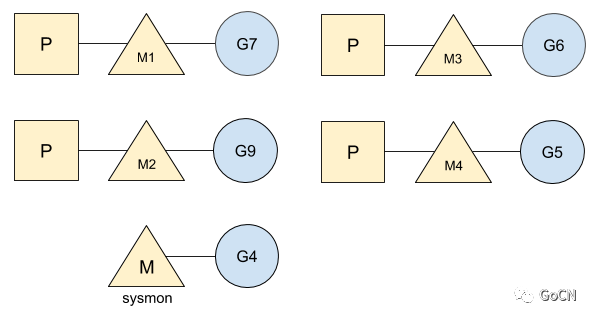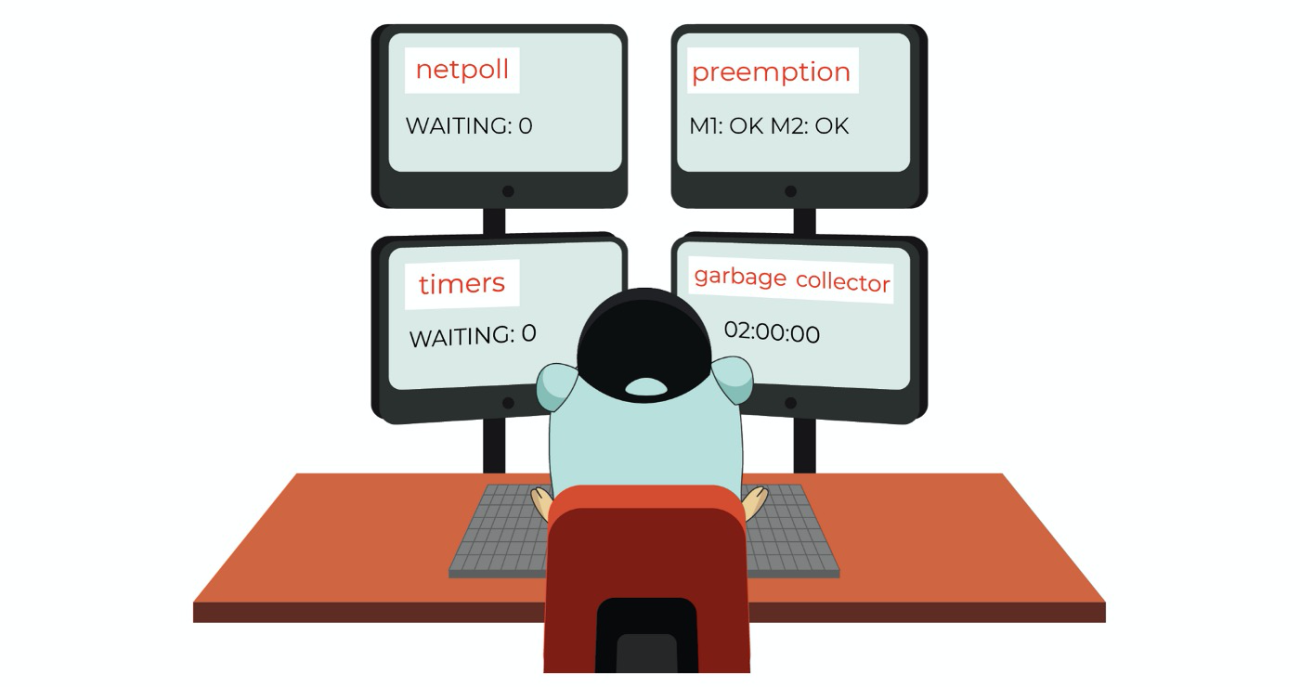认识Golang中的sysmon监控线程
admin
- 4 minutes read - 835 wordsGo Runtime 在启动程序的时候,会创建一个独立的 M 作为监控线程,称为 sysmon,它是一个系统级的 daemon 线程。这个sysmon 独立于 GPM 之外,也就是说不需要P就可以运行,因此官方工具 go tool trace 是无法追踪分析到此线程( 源码)。 sysmon
sysmon
在程序执行期间 sysmon 每隔 20us~10ms 轮询执行一次( 源码),监控那些长时间运行的 G 任务, 然后设置其可以被强占的标识符,这样别的 Goroutine 就可以抢先进来执行。
// src/runtime/proc.go
// forcegcperiod is the maximum time in nanoseconds between garbage
// collections. If we go this long without a garbage collection, one
// is forced to run.
//
// This is a variable for testing purposes. It normally doesn't change.
var forcegcperiod int64 = 2 * 60 * 1e9
// Always runs without a P, so write barriers are not allowed.
//
//go:nowritebarrierrec
func sysmon() {
......
for {
if idle == 0 { // start with 20us sleep...
delay = 20
} else if idle > 50 { // start doubling the sleep after 1ms...
delay *= 2
}
if delay > 10*1000 { // up to 10ms
delay = 10 * 1000
}
usleep(delay)
......
}
......
}
说明一下,在 sysmon() 函数里有一个[sched](https://github.com/golang/go/blob/go1.15.6/src/runtime/runtime2.go#L1041) 变量,这个是全局变量,它是整个调度器调度必须使用的一个全局变量,对应结构体为 [schedt](https://github.com/golang/go/blob/go1.15.6/src/runtime/runtime2.go#L698-L781), 对应字段注释我们 golang中G、P、M 和 sched 三者的数据结构 文章里已介绍过。
sysmon工作职责
在 GPM 模型中,我们知道当一个 G 由于网络请求或系统调用sysycall导致运行阻塞时,go runtime scheduler 会对其进行调度,把阻塞 G 切换出去,再拿一个新的G继续执行,始终让P处于全部运行状态。
那么切换出去的 G 什么时候再回来继续执行呢?这就是本文要讲的 sysmon 监控线程。 sysmon 工作职责
sysmon 工作职责
网络轮询器监控
在GPM模型中当由于 网络请求 而导致的运行阻塞时,调度器会让当前阻塞的G放入网络轮询器(NetPoller)中,由网络轮询器处理异步网络调用,从而出让 P 和 M ,这时 M 再从 P 的 LRQ 队列里取一个 goroutine 继续执行。当异步网络调用由网络轮询器完成后,再由sysmon监控线程将其切换回来继续执行。
从 runtime 的实现源码中可以看到, sysmon 监控线程会每隔 20us~10ms 轮询一次检查当前网络轮询器中的所有 G 距离上次 runtime.netpoll 被调用是否超过了10ms,如果当前G执行时间太长了,则通过 injectglist() 将其放入 全局运行队列 ,等待下一次的继续执行。
对于
sysmon线程来说,它的执行是完全脱离P运行的,所以不可能会放回本地运行队列。但在findrunnable()函数里调用injectglist()函数是可以放入P
主要相关函数 netpoll() 和 injectglist(),这里 netpoll() 函数是linux平台,不同平台所在的文件有所差异。
// src/runtime/proc.go
func sysmon() {
......
for {
......
// poll network if not polled for more than 10ms
lastpoll := int64(atomic.Load64(&sched.lastpoll))
if netpollinited() && lastpoll != 0 && lastpoll+10*1000*1000 < now {
atomic.Cas64(&sched.lastpoll, uint64(lastpoll), uint64(now))
list := netpoll(0) // non-blocking - returns list of goroutines
if !list.empty() {
// Need to decrement number of idle locked M's
// (pretending that one more is running) before injectglist.
// Otherwise it can lead to the following situation:
// injectglist grabs all P's but before it starts M's to run the P's,
// another M returns from syscall, finishes running its G,
// observes that there is no work to do and no other running M's
// and reports deadlock.
incidlelocked(-1)
injectglist(&list)
incidlelocked(1)
}
}
......
}
......
}
系统调用syscall监控
如果是系统调用导致阻塞的话(P的状态为 _Psyscall),则从 GMP 模型中将 GM 切换出去,这样即保证了系统调用的继续执行,又节省出一个空闲的 P, 这种情况下 P 将重新找一个空闲 M (如果没有空间的 M 将重新创建一个 M ),然后再优先从当前 P 的 LRQ 队列里取一个 G ,重新组成 GMP 模型继续执行。可以看到这里是充分将 P 资源利用起来。
// src/runtime/proc.go
func sysmon() {
......
for {
......
// retake P's blocked in syscalls
// and preempt long running G's
if retake(now) != 0 {
idle = 0
} else {
idle++
}
......
}
......
}
syscall 主要通过调用 [retake()](https://github.com/golang/go/blob/go1.15.6/src/runtime/proc.go#L4769-L4840) 函数,抢占长时间处于 _Psyscall 状态的P。
// forcePreemptNS is the time slice given to a G before it is
// preempted.
const forcePreemptNS = 10 * 1000 * 1000 // 10ms
func retake(now int64) uint32 {
n := 0
// 全局p锁
lock(&allpLock)
// 遍历每个P
for i := 0; i < len(allp); i++ {
_p_ := allp[i]
// 1. p == nil 说明通过runtime.GOMAXPROCS 动态对P进行了调大,但当前还未初始化使用 直接跳过
if _p_ == nil {
// This can happen if procresize has grown
// allp but not yet created new Ps.
continue
}
//
pd := &_p_.sysmontick
s := _p_.status
sysretake := false
// 2. P的状态为 _Prunning或_Psyscall的情况
if s == _Prunning || s == _Psyscall {
// Preempt G if it's running for too long.
// 运行时间过长
t := int64(_p_.schedtick)
// 如果 p.sysmontick.schedtick != p.schedtick,则进行次数同步,并指定调度时间为now
if int64(pd.schedtick) != t {
pd.schedtick = uint32(t)
pd.schedwhen = now
} else if pd.schedwhen+forcePreemptNS <= now {
// 如果 p上次调度时间 + 10ms <= now,说明下次调度的时候有点长,需要立即进行调度
// 但是当前P 是_Psyscall 状态的话,并不会抢占P,因为这种情况下M并没有与P绑定
preemptone(_p_)
// In case of syscall, preemptone() doesn't
// work, because there is no M wired to P.
sysretake = true
}
}
// 3. 系统调用
if s == _Psyscall {
// Retake P from syscall if it's there for more than 1 sysmon tick (at least 20us).
t := int64(_p_.syscalltick)
if !sysretake && int64(pd.syscalltick) != t {
pd.syscalltick = uint32(t)
pd.syscallwhen = now
continue
}
// On the one hand we don't want to retake Ps if there is no other work to do,
// but on the other hand we want to retake them eventually
// because they can prevent the sysmon thread from deep sleep.
if runqempty(_p_) && atomic.Load(&sched.nmspinning)+atomic.Load(&sched.npidle) > 0 && pd.syscallwhen+10*1000*1000 > now {
continue
}
// Drop allpLock so we can take sched.lock.
unlock(&allpLock)
// Need to decrement number of idle locked M's
// (pretending that one more is running) before the CAS.
// Otherwise the M from which we retake can exit the syscall,
// increment nmidle and report deadlock.
incidlelocked(-1)
if atomic.Cas(&_p_.status, s, _Pidle) {
if trace.enabled {
traceGoSysBlock(_p_)
traceProcStop(_p_)
}
n++
_p_.syscalltick++
handoffp(_p_)
}
incidlelocked(1)
lock(&allpLock)
}
}
// 全局p锁
unlock(&allpLock)
return uint32(n)
}
队此之外还有由于原子、互斥量或通道操作调用导致 Goroutine 阻塞或直接调用 sleep 导致的阻塞也会导致调度器对G进行切换。
垃圾回收
如果垃圾回收器超过两分钟没有执行的话,sysmon 监控线程也会强制进行GC,参考文章: https://blog.haohtml.com/archives/23911。
// src/runtime/proc.go
func sysmon() {
......
for {
......
// check if we need to force a GC
if t := (gcTrigger{kind: gcTriggerTime, now: now}); t.test() && atomic.Load(&forcegc.idle) != 0 {
lock(&forcegc.lock)
forcegc.idle = 0
var list gList
list.push(forcegc.g)
injectglist(&list)
unlock(&forcegc.lock)
}
......
}
......
}
其它
另外还有一些其它作用,如函数 timeSleepUntil() 用来获取 Timers 的下次执行时间
参考资料
- https://zhuanlan.zhihu.com/p/248697371
- https://zhuanlan.zhihu.com/p/27328476
- Go netpoller 网络模型之源码全面解析
- Go 为什么这么“快”